 |
| Voigtländer Bessa RF with Ilford HP3 |
Monday last week was
Expired Film Day. Like a number of other film-themed days throughout the year, it's one I tend to observe, and last year's happened to be a little over a week before the pandemic restrictions came in to force in the UK; indeed, the weekend of
Expired Film Day 2020 I received notification that my employer was moving to remote working for the foreseeable future. Expired Film Day 2021, on the 15th of March was a week after schools had reopened for face-to-face teaching, but the general stay at home order was still in place in England, but the allowance of daily exercise provided the opportunity to take some photographs while taking a walk around my local area.
 |
| Ilford HP3 roll film, dated June 1965 |
At Christmas, I'd been given some expired film, two rolls of Kodak Tri-X and one roll of medium format Ilford HP3. This was dated June 1965 on the box, with a leaflet inside with Ilford's date code for November 1961; the date on the box is not prefixed by "develop before" or "process by", so this could just conceivably be the date of manufacture, which I've seen used on glass plates before. It is of course more likely to be a 'develop before' date, which would mean that the film would have probably been manufactured three or four years earlier, making it very close to 60 years old. The felicity of having this roll as a recent, thoughtful present made it a natural choice for the day.
 |
| ORWO NP20 refill tin |
As well as the medium format HP3, I also shot some 35mm film. This wasn't the Kodak Tri-X though: I wanted to test a few frames from one of the two rolls for exposure and development, something easier to do with 35mm film (the Tri-X weren't in their cartons, so had no 'process before' date, but the style of the metal film canisters looked as though these were also from the 1960s. However, I decided not shoot these as). Instead, I shot a roll of Orwo NP20 film. This had come in a metal tin which contained three lengths of 170cm-long film for reloading 35mm cassettes, complete with ready-cut leaders. Having seen boxes of 35mm Ilford refills in the past, it seems that this was not an uncommon way to buy 35mm film, as opposed to 100ft bulk film, which requires a bulk loader. In contrast, the 35mm refills simply need to be loaded into a reusable cassette in the dark. The Orwo NP20 film had a date of January 1973, and I had already used two of the three refills, so knew a rough exposure index for the film, which I generally rated at 40 (the '20' in the name is its speed in DIN rating, equivalent to 80 ISO). I had also discovered this film to be fogged quite considerably at its top and bottom edges.
Although the day had periodic clear spells, by the time I left the house for my allowed exercise, it was towards the end of the afternoon, and a large, long bank of clouds had moved in, obscuring the setting sun. As a result, the lighting conditions weren't as good as I had hoped, and I pretty much shot all the frames on both films with the lenses of both cameras wide open (I could have taken a tripod, but this feels as though it goes against the spirit, at least, of the current regulations: leaving the house to take a walk for exercise, and taking some photographs while doing so, as opposed to leaving the house to take photographs). I shot the Ilford HP3 film with the Voigtländer Bessa, which has an f3.8 lens, the fastest of my medium format folding cameras; I used the Kiev-4 for the Orwo NP20. Both cameras are rangefinders, which might make focussing easier in low-light, certainly when compared to scale-focus cameras when hand-holding the cameras demanded wide apertures (and relatively slow shutter speeds too). With the Orwo film, I did bracket quite a few shots, daring to use as low as 1/10th in a few instances with some form of support (a tree, or a railing) whereas, with only eight shots on the HP3 in 6c9 format, I didn't bracket. I did start shooting the Bessa at 1/100th at f3.8, but by the last couple of shots where I could tell the light was lower than when I had first left the house, I used 1/25th, hardly ideal for a medium format camera with a 105mm lens.

Ordinarily, I might have stand developed both films, both being long-discontinued emulsions, and something which is usually a good strategy to get a useable negative in such circumstances. However, the leaflet inside the HP3 box did provide some developing times for a handful of developers, and one, PQ Universal, was one that I happened to have to hand. PQ Universal was one of a number of 'universal' developers which could be used for both film and paper development; it's still made by Ilford at the time of writing, but is listed as a paper developer and is
not recommended for 35mm or medium format; the leaflet with the film does state that PQ Univeral can be used "if contact prints are to be made". I considered that, given its age, I wasn't too concerned with obtaining a fine-grained negative from the roll of HP3, so used the PQ Universal as directed, diluting it at 1+19, and developing the film for 7 minutes at 20ºC. Allowing for the age of the film and the lighting conditions when taking the photographs, the PQ Universal worked well enough.
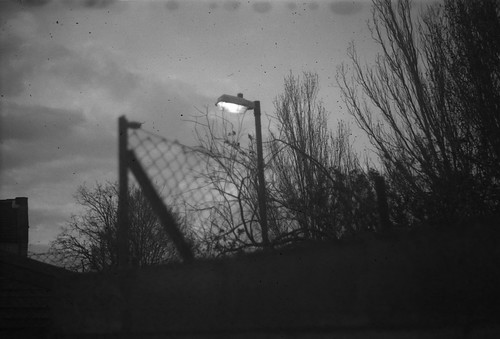 |
| Voigtländer Bessa RF with Ilford HP3 |
 |
Voigtländer Bessa RF with Ilford HP3
|
The first couple of frames (above) from the roll did have a lot of blank spots on the negative, showing up as black in the scans above, which I think may have been from the decaying strip of tape, originally holding the film to its backing paper. When advancing the film to the first frame, this needed a moderate amount of force, and was rather noisier than expected: the tape had hardened over the decades and the adhesive given up, and when I came to develop the film, the tape was loose, and must have come off the film when it flattened in moving through the camera to the take-up spool. Fortunately, the rest of the film came with it.
I also had a few issues with focus, possibly less critical had I not shot everything wide open. One shot was out of focus simply due to user error: the last of the two shots above was focused down to 1 metre; after taking the shot, I recall distinctly thinking that the Bessa allows the user to close it when focused at any distance, unlike some other folding cameras (notably the Retina); minutes later, I opened the camera again to photograph a cloud formation without remembering to re-focus it (the rangefinder window is separate from the viewfinder, which makes this an easier mistake to make). I subsequently took another photograph of the sky, successfully focussed at infinity (at the time, the subject of these shots I thought would be sufficiently bright to register on the film if nothing else came out).
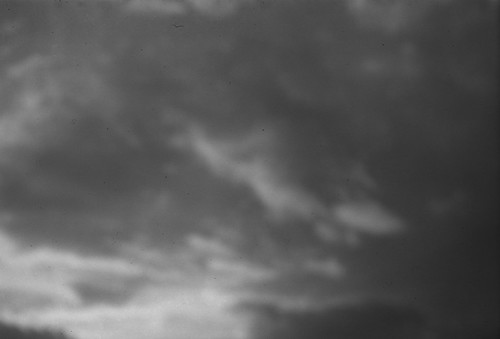 |
| Voigtländer Bessa RF with Ilford HP3 |
 |
| Voigtländer Bessa RF with Ilford HP3 |
In the first shot below, I had thought I had focussed the camera on the furthest chairs in the middle distance, but the buildings in the distance are in focus, which, again, might be user error or that the rangefinder is a little out of calibration, less obvious at smaller apertures. The second shot below isn't especially well framed, possibly I hadn't taken into account parallax error - the Bessa's viewfinder has no framelines or adjustments for this (I could have cropped the frame to centre to subject–and probably would if I were to print the negative–but have chosen not to here).
 |
| Voigtländer Bessa RF with Ilford HP3 |
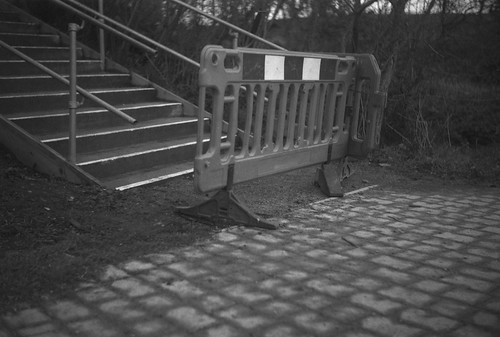 |
| Voigtländer Bessa RF with Ilford HP3 |
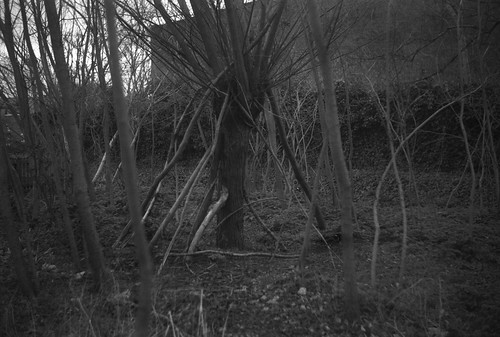 |
| Voigtländer Bessa RF with Ilford HP3 |
To develop the Orwo NP20 film, I found that it's listed on the Massive Dev Chart, under the
'discontinued & obsolete' category: I used the time from the chart with Rodinal diluted 1+50. This film had aged less well than the Ilford HP3, and the edge fogging was particularly obtrusive in some frames, but, with sufficient exposure, this was much less apparent. Subject also made a difference: some compositions suffered less as a result, others more so. In some cases I also used the burn tool in Photoshop along the edges, but only doing what I would do when printing in the darkroom
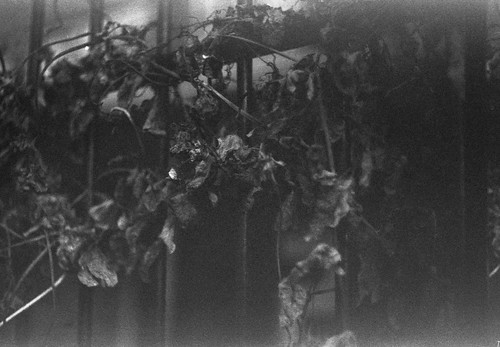 |
| Kiev-4 with Orwo NP20 |
 |
| Kiev-4 with Orwo NP20 |
 |
| Kiev-4 with Orwo NP20 |
As an example of how sufficient exposure mitigates the edge fogging, the three frames below show three successive exposures, with shutter speeds from 1/50th, to 1/25th and 1/10th, and the fogging is hard to discern on the last frame (I also trust the rangefinder on my Kiev-4, so any softness of focus is that of the Helios lens and camera shake). Of course, too much exposure starts to compress the tones in the highlights and mid-tone range, and I think this may just be making itself apparent in the third frame in the sequence below.
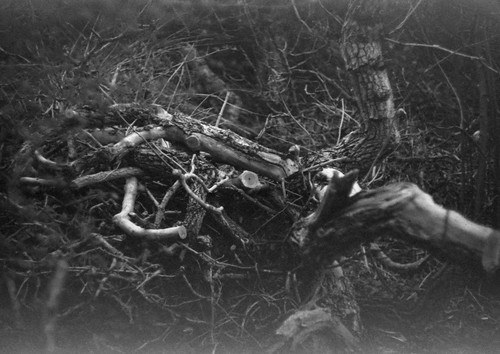 |
| Kiev-4 with Orwo NP20 |
 |
| Kiev-4 with Orwo NP20 |
 |
| Kiev-4 with Orwo NP20 |
Having 36 frames on the roll of Orwo NP20 at least allowed for such bracketing, which I did not want to do on the more limited length of the medium format roll; naturally, though, I did shoot some of the same subjects on both films in both formats, but pretty much prefer the medium format versions in all cases.
 |
| Kiev-4 with Orwo NP20 |
 |
| Kiev-4 with Orwo NP20 |
 |
| Kiev-4 with Orwo NP20 |
 |
| Kiev-4 with Orwo NP20 |





















No comments:
Post a Comment